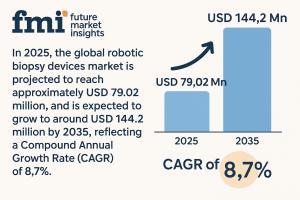Global Robotic Biopsy Devices Market Set to Surge, Projected to Reach USD 144.2 Million by 2035 | FMI
Explore emerging trends, innovations, and market forecasts driving the growth of robotic biopsy devices from 2025 to 2035
Robotic biopsy devices represent a new frontier in diagnostic medicine—delivering minimally invasive, image-guided tissue sampling with enhanced accuracy, safety, and speed. These systems, comprising robotic arms, real-time imaging technologies (MRI, CT, and ultrasound), artificial intelligence (AI)-driven navigation software, and integrated tracking platforms, have emerged as essential tools for oncologists, radiologists, and surgeons across the globe.
Stay Updated with Market Movements: Get Your Sample Report! https://www.futuremarketinsights.com/reports/sample/rep-gb-15412
Market Drivers: The Confluence of Innovation and Healthcare Demand
Several macroeconomic and technological trends are driving adoption across the robotic biopsy devices market. Chief among them is the rising incidence of cancer globally, which is fueling the demand for early, accurate, and less invasive diagnostic procedures. According to global cancer statistics, early detection significantly increases treatment efficacy and survival rates—creating a pressing need for more precise diagnostic systems.
Simultaneously, the healthcare industry’s accelerated embrace of AI and robotics—especially in surgery and diagnostics—is propelling the evolution of biopsy techniques. Robotic biopsy systems, integrated with advanced imaging and real-time analytics, offer consistency and reproducibility in tissue sampling, reducing human error and patient trauma.
In addition, the surge in hospital automation investments, rising prominence of digital pathology, and government-backed cancer screening programs are catalyzing the commercial and clinical deployment of robotic biopsy technologies.
Regional Outlook: North America Leads, Asia-Pacific Rising
Regionally, North America continues to dominate the global robotic biopsy devices market, driven by robust healthcare infrastructure, strong R&D investment, and early adoption of emerging medical technologies. The U.S., in particular, has witnessed growing implementation of robotic biopsy systems in leading hospitals and academic centers.
Europe is witnessing a steady rise in market penetration, aided by favorable reimbursement policies and increasing adoption of minimally invasive diagnostics. Meanwhile, the Asia-Pacific region is projected to experience the fastest growth during the forecast period, owing to rising cancer prevalence, improving healthcare access, and growing investments in medical technology in countries such as China, India, and South Korea.
Eastern Europe, Latin America, and the Middle East & Africa are also expected to see gradual adoption, supported by public health initiatives and international partnerships aimed at upgrading diagnostic capabilities.
Market Trends and Success Factors
Several industry-wide trends are reshaping the robotic biopsy devices landscape:
• Integration of AI for real-time navigation, enhancing tissue targeting accuracy.
• Expansion of multi-modal imaging systems enabling seamless procedural visualization.
• Growing preference for day-care diagnostic procedures, supporting the rise of outpatient and ASC-based biopsies.
• Cross-disciplinary collaboration between medtech companies, academic institutions, and healthcare providers to drive product innovation.
Recent industry developments reflect increasing momentum. Notable examples include partnerships between robotic surgical platforms and imaging companies, as well as FDA approvals of novel robotic biopsy systems designed for soft tissue sampling.
Elevated Market Interest: Delve into In-Depth Trends and Insights with Our Full Report! https://www.futuremarketinsights.com/reports/robotic-biopsy-devices-market
Challenges and Opportunities
While the outlook is promising, certain challenges persist. High upfront costs and complexity of robotic systems may limit adoption in resource-constrained settings. Additionally, the need for specialized training and integration into existing clinical workflows poses a learning curve for many providers.
Nevertheless, these challenges are counterbalanced by significant opportunities:
• Expansion into emerging economies with rising healthcare spending.
• Integration with electronic health records (EHRs) and telepathology systems for remote diagnostics.
• Development of compact, portable robotic systems suitable for point-of-care diagnostics.
Competitive Landscape: Innovation at the Core
The robotic biopsy devices market is characterized by a mix of established medtech players and agile innovators. Leading companies are heavily investing in R&D, strategic acquisitions, and collaborative development to stay ahead in this high-growth segment.
Key players include
• Medtronic – Renowned for their extensive surgical robotics portfolio.
• Renishaw plc – Specializes in neurosurgical robotic systems.
• iSYS Medizintechnik GmbH – Focuses on minimally invasive robotic-guided interventions.
• Mazor Robotics (now part of Medtronic) – Known for spine and brain robotics.
• Biobot Surgical Pte Ltd – Pioneers in prostate biopsy robotics.
• Medrobotics – Offers flexible, snake-like robots for difficult-to-access anatomical regions.
• Medtech SA – Acquired by Zimmer Biomet; involved in robotic brain surgery.
• Accuray Inc. – Known for integrating radiation therapy with precision biopsy.
• Auris Health, Inc. (now part of Ethicon/Johnson & Johnson) – Developer of robotic bronchoscopes.
• Hologic, Inc. – A major player in women's health and breast biopsy devices.
These companies are expected to play a central role in shaping the future of robotic diagnostics, not only by enhancing technological capabilities but also by making robotic biopsies more accessible and standardized across global healthcare settings.
Market Segmentation: Diverse Applications and End Users
The robotic biopsy devices market is categorized across several key segments:
By Product:
• Systems: These include complete robotic platforms designed for automated or semi-automated biopsy procedures.
• Instruments & Accessories: Biopsy needles, probes, software, and ancillary components that support robotic operation.
By Application:
• Brain Biopsy: Utilized in neurosurgery for minimally invasive tissue sampling in suspected tumors or lesions.
• Lung Biopsy: Allows for highly precise sampling of nodules and lesions within delicate pulmonary tissue.
• Prostate Biopsy: Frequently performed in prostate cancer diagnostics with the aid of transrectal ultrasound (TRUS) and MRI fusion.
• Others: Includes breast, liver, and kidney biopsies, where robotic systems enhance procedural precision and minimize complications.
By End User:
• Hospitals: Leading adopters of robotic biopsy systems due to their ability to offer comprehensive diagnostic services and manage complex cases.
• Ambulatory Surgical Centers (ASCs): Emerging as cost-effective alternatives for outpatient diagnostic procedures.
• Academic & Research Institutes: Critical to technological innovation, testing, and clinical validation of robotic biopsy technologies.
Stay Ahead: Subscribe for Weekly Healthcare Market Updates! https://www.futuremarketinsights.com/industry-analysis/therapeutic-device
Future Outlook
As healthcare systems continue to prioritize early cancer detection and minimally invasive diagnostics, robotic biopsy devices are set to become a mainstay in clinical practice. With advancements in AI, miniaturization, and image fusion technologies, the next decade will likely see a broader scope of applications, improved procedural workflows, and increased affordability.
The robotic biopsy revolution is not just about machines—it’s about redefining precision in patient care. Stakeholders across the healthcare ecosystem—from device manufacturers to providers and policymakers—must collaborate to ensure these innovations translate into better outcomes for patients around the world.
Explore FMI’s Related Ongoing Coverage on Healthcare Market Insights Domain:
Robotic Catheterization Systems Market Outlook from 2025 to 2035: https://www.futuremarketinsights.com/reports/robotic-catheterization-systems-market
Robotic Assisted Endovascular Systems Market Analysis – Trends & Forecast 2023-2033: https://www.futuremarketinsights.com/reports/robotic-assisted-endovascular-systems-market
Medical Rehabilitation Robotics Market Outlook from 2025 to 2035: https://www.futuremarketinsights.com/reports/medical-rehabilitation-robotics-market
About Future Market Insights (FMI)
Future Market Insights, Inc. (ESOMAR certified, recipient of the Stevie Award, and a member of the Greater New York Chamber of Commerce) offers profound insights into the driving factors that are boosting demand in the market. FMI stands as the leading global provider of market intelligence, advisory services, consulting, and events for the Packaging, Food and Beverage, Consumer Technology, Healthcare, Industrial, and Chemicals markets. With a vast team of over 400 analysts worldwide, FMI provides global, regional, and local expertise on diverse domains and industry trends across more than 110 countries.
Contact Us
Future Market Insights Inc.
Christiana Corporate, 200 Continental Drive,
Suite 401, Newark, Delaware - 19713, USA
T: +1-347-918-3531
For Sales Enquiries: sales@futuremarketinsights.com
Website: https://www.futuremarketinsights.com
LinkedIn| Twitter| Blogs | YouTube
Ankush Nikam
Future Market Insights, Inc.
+91 90966 84197
email us here
Visit us on social media:
LinkedIn
Facebook
YouTube
X
Legal Disclaimer:
EIN Presswire provides this news content "as is" without warranty of any kind. We do not accept any responsibility or liability for the accuracy, content, images, videos, licenses, completeness, legality, or reliability of the information contained in this article. If you have any complaints or copyright issues related to this article, kindly contact the author above.
Key Housing Announces August Featured Listing for Bakersfield Short-term Housing
Hands-On Diagnostics Announces Annual Symposium to Help Physical Therapists Improve Patient Outcomes
Injury Law Firms Face Personal Liability Crisis as TCPA Violations Surge 112%, Costing Industry $500 Million Annually
Więcej ważnych informacji
 Jedynka Newserii
Jedynka Newserii

 Jedynka Newserii
Jedynka Newserii

Konsument

Grupa nowych biednych emerytów stale się powiększa. Ich świadczenie jest znacznie poniżej minimalnej emerytury
Przybywa osób, które z powodu zbyt krótkiego czasu opłacania składek pobierają emeryturę niższą od minimalnej. Tak zwanych nowych biednych emerytów jest w Polsce ok. 430 tys., a zdecydowaną większość grupy stanowią kobiety – wskazują badania ekspertów Instytutu Pracy i Spraw Socjalnych. W ich przypadku krótszy okres składkowy zwykle wynika z konieczności opieki nad dziećmi lub innymi osobami w rodzinie. Wśród innych powodów, wymienianych zarówno przez panie, jak i panów, są także praca za granicą lub na czarno oraz zły stan zdrowia.
Media i PR
M. Wawrykiewicz (PO): Postępowanie z art. 7 przeciw Węgrom pokazało iluzoryczność tej sankcji. Unia wywiera naciski poprzez negocjacje nowego budżetu

Przykład Węgier pokazał, że procedura z artykułu 7 traktatu o UE o łamanie praworządności nie ma mocy prawnej z powodu braku większości, nie mówiąc o jednomyślności wśród pozostałych państw członkowskich. Negocjacje nowego budżetu UE to dobry pretekst do zmiany sposobu części finansowania z pominięciem rządu centralnego. Czerwcowy marsz Pride w Budapeszcie pokazał, że część społeczeństwa, głównie stolica, jest przeciwna rządom Viktora Orbána, ale i na prowincji świadomość konsekwencji działań Fideszu staje się coraz większa przed przyszłorocznymi wyborami.
Firma
Blockchain zmienia rynek pracy i edukacji. Poszukiwane są osoby posiadające wiedzę z różnych dziedzin

Zapotrzebowanie na specjalistów od technologii blockchain dynamicznie rośnie – nie tylko w obszarze IT, ale również w administracji, finansach czy logistyce. Coraz więcej uczelni wprowadza programy związane z rozproszonymi rejestrami, które wyposażają studentów w umiejętności odpowiadające wymogom rynku.
Partner serwisu
Szkolenia

Akademia Newserii
Akademia Newserii to projekt, w ramach którego najlepsi polscy dziennikarze biznesowi, giełdowi oraz lifestylowi, a także szkoleniowcy z wieloletnim doświadczeniem dzielą się swoją wiedzą nt. pracy z mediami.


![Nestlé w Polsce podsumowuje wpływ na krajową gospodarkę. Firma wygenerowała 0,6 proc. polskiego PKB [DEPESZA]](https://www.newseria.pl/files/1097841585/fabryka-nesquik_1,w_85,r_png,_small.png)






.gif)

 |
| |
| |
|